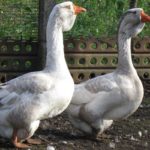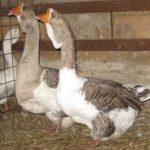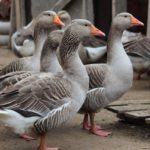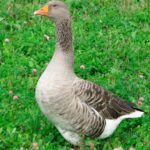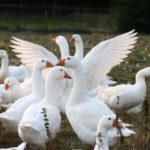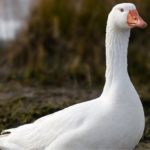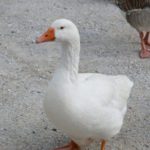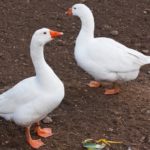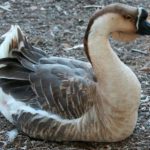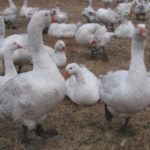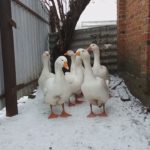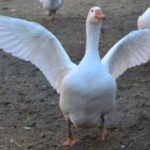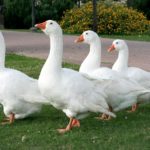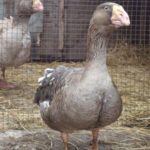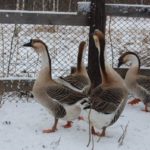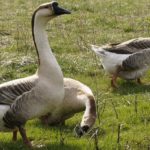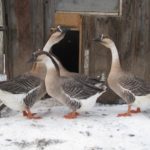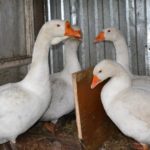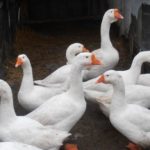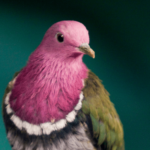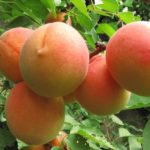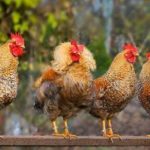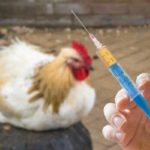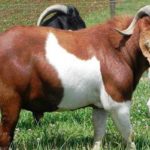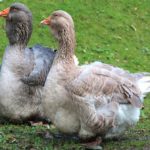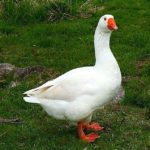Geese are large birds and easy to keep. They fatten quickly, do not get sick, and are ready for slaughter by 4-5 months. Of course, of all the varieties, poultry farmers try to choose the largest breeds of geese, because raising them can be the most profitable in an economic sense. Let's consider the description and characteristics of large goose breeds, their advantages and disadvantages.
Information about the meat sector
Raising large geese is popular all over the world.This business is profitable and therefore widespread. Birds have a large body and weight; the breeds belong to the meat breed. That is, birds are mainly fattened for meat. But this does not mean that you cannot get eggs from geese, although such varieties are much lower in this indicator than egg-laying varieties. Let's look at several large goose breeds, the breeding of which can be recommended for farmers and private poultry owners.
The largest breeds of geese
Breeds whose representatives have a large body were bred both in Russia and in other countries. But, in addition to common features, they also have differences. Both in appearance and in productivity. Let's look at the characteristics of some varieties, their pros and cons.
Kholmogory goose
Bred in the 19th century, it produces juicy, tender meat, not fatty. This is one of the breeds that is often raised for meat at home. Kholmogory geese with a strong body and a wide back. Orange beak with a bump, white or grayish plumage. The number of eggs per year is 30 pieces. An adult bird weighs 8-12 kg.
Large Ukrainian gray
Descendants of Romny and Toulouse geese can grow up to 5 kg at 2 months. By the time of slaughter they already weigh 9 kg. The breed's egg production is 4 dozen per season.
Large grays are often chosen for breeding in Ukraine and some regions of Russia.
Legart Danish
Refers to broilers. At 2 months, goslings weigh more than 4 kg, and then the weight gain only increases.
Despite the shortcomings, farmers are trying to purchase Danish geese and raise them in their backyards.
Governor's geese
A new breed bred from Shadrinsky and Italian whites. The plumage is white. At 9 weeks, the weight of the gander reaches 4.3 kg, the goose - 4 kg.
No disadvantages of the Governor breed have been found, except that incubation material and young animals are not easy to obtain, since the variety is new.
Chinese geese
Bred from wild geese that were domesticated centuries ago. There are 2 subtypes - white and gray with a brownish pattern. Dark-colored birds have a black beak and orange legs. The weight of the gander is more than 5 kg, the goose is 4.2 kg.
Considering the advantages and disadvantages of the breed, it should be noted that it has more advantages than disadvantages. More details here.
Mamut
The Danish breed is bred from the Land goose with white plumage and the Toulouse goose with gray plumage. The weight of an adult gander is 13 kg, a goose weighs up to 10 kg, so the mamut can safely be called one of the largest geese.
Despite the high cost, the breed's representatives are worth paying their price for.
Ural whites
The plumage is gray, the beak and legs are yellow-orange. At 3 months, a Ural gosling can weigh 5 kg, an adult - 9-6.5 kg. Egg production is average - 4 dozen eggs.
No disadvantages were found in the white Ural breeds.
Tula bird
The gander of this breed weighs 5-6.5, the goose - 5.2-5.5 kg, but some specimens reach 7-8 kg.
Due to its aggressive nature, the breed does not get along with other animals.
Kuban gray
Bred, as the name suggests, in Kuban.
Linda
Linda gosling at 3 months it weighs 4 kg, at 5 – 7 kg, at a year it reaches 11 kg.
Record holders
Geese themselves are considered one of the heaviest poultry. But even among them, not all have the same mass. Of all the heavyweights, the leaders are considered to be Toulouse, which reach up to 16 kg, Kholmogory, and Mamut. The varieties belong to the meat category; goslings can be raised as broilers. By 4 months, goslings of many breeds, which are recognized as the best in the world, on a standard diet without any problems gain a weight of 5 kg.
The advantages of the breed include not only a large body and the speed of gaining muscle mass, but also resistance to external factors and good health.Of course, the egg production of heavyweights is low, but this is how it should be, because the energy of the feed is spent on creating mass. But geese of some breeds can lay eggs relatively well, so the eggs obtained from them are enough for home use.
The poultry business is considered profitable; provided that the goose farm is properly fed with inexpensive feed and the maintenance rules are followed, it can generate significant profits.
Large breeds of geese are distinguished by the fact that they grow quickly, have a large body, and have a high slaughter yield of meat. The varieties are ideally suited for growing for meat, both for personal consumption and for making a profit from meat breeding of geese. It is especially effective to raise birds as broilers; by the age of 4-5 months they produce carcasses, the profitability of which is the lowest. The meat is not fatty, tasty, and you can get the product by feeding the bird with regular feed or mixed feed.


